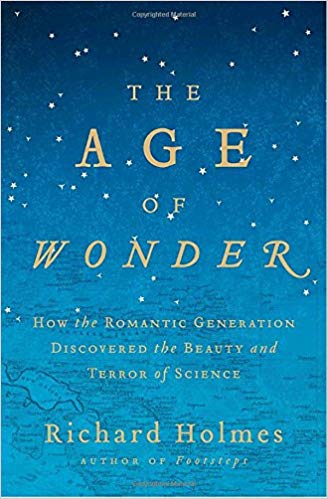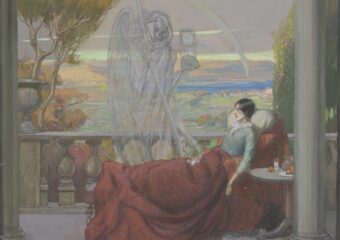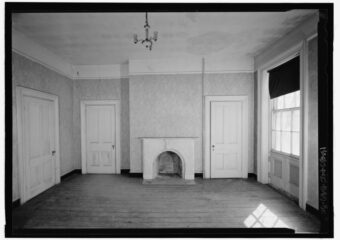Richard Holmes
Pantheon Books
New York
2008
552 pages
According to the Art:
Richard Holmes refers to this book as his “account of the second scientific revolution, which swept through Britain at the end of the eighteenth century, and produced a new vision which has rightly been called Romantic science.” The book is a reminder that the sciences and the arts are similar undertakings at their roots, and makes a call for a reuniting of the sciences and the arts, which Medical Humanities attempts to answer.
Synopsis:
Richard Holmes refers to this book as his “account of the second scientific revolution, which swept through Britain at the end of the eighteenth century, and produced a new vision which has rightly been called Romantic science.” (p. xv) He pins the first scientific revolution to the seventeenth century and centers it on the work of Newton, Hooke, Locke, and Descartes. He brackets the second around 1768, when James Cook began his voyage circumnavigating the world, and 1831, when Charles Darwin began his voyage to the Galapagos Islands. Holmes calls this period “The Age of Wonder.”
Cook’s voyage carried Joseph Banks among its crew. Banks, a young man of great wealth and privilege, joined the expedition as a botanist to assist in the collection of botanical and zoological specimens from stops in the southern hemisphere. He was successful in this endeavor, and made observations about island life along the way, especially while on Tahiti. A few years after his return, he became the president of the Royal Society and would remain so for the next forty–two years.
The Society offered scientists (known then as “natural philosophers”) a place to publish papers, present findings, gain notoriety, receive funding, and develop networks. In his role as president, Banks was connected to many of the scientists included in the book.
William Herschel and Humphrey Davy are the most prominent figures Holmes covers. Herschel was an accomplished musician and amateur astronomer until he built telescopes that helped him see, characterize, and record heavenly bodies never seen before. While conventional thinking of the time considered the universe to be static, placed by a divine hand, Herschel viewed it as continually evolving. Holmes gives Herschel’s sister, Caroline, her just due as first his assistant and then as a noted astronomer in her own right.
Holmes focuses on Davy’s more well-known advances in chemistry: finding new elements; analyzing human effects of gasses comprising “common air” and “factitious airs” (e.g., nitrous oxide); inventing a safety lamp for miners; and applying the voltaic battery to chemical analysis. Holmes also details Davy’s role as a popularizer of science through well-received public lectures.
Aside from a chapter on Mungo Park’s ill-fated expedition to Africa, the other chapters have less focus on individuals and more on notable events. One concerns the first flights of hot air balloons, and another on the speculations of electricity as a life force that led to Mary Shelly’s novel, Frankenstein; Or, The Modern Prometheus. The final two chapters are in the service of Holmes’s view that “Science is truly a relay race, with each discovery handed on to the next generation.” (p.468). He identifies the next generation of scientists and pays particular attention to William Herschel’s son, John, and to Davy’s protégé, Michael Faraday. Both went on to accomplished and celebrated careers.
Holmes embeds the historical scientific developments and legendary figures into the ordinary daily life and human follies of the time. He describes how scientists and explorers sought public and private funding, and how they collaborated with one other on some occasions and competed with one another on others. We read of court intrigues, societal jostling, courtships and marriages, extramarital affairs (chaste and tawdry), and family relationships (devoted and fractious). A broader context Holmes provides involves the interplay among the scientists and explorers he covers and some of the important figures in literature, poetry, and art of Romantic era. Samuel Coleridge, William Cowper, John Keats, Mary Shelley, Percy Bysshe Shelley, Robert Southey, and Joseph Wright of Derby among others make appearances in the stories Holmes tells. He details the friendships between them and the influences they had on each other.
Analysis:
The book is a reminder that the sciences and the arts are similar undertakings at their roots. Holmes makes this point when he refers to “Romantic science” and “Romantic scientists,” which ties the science of that time to the literature, art, and philosophy of the Romantic era. Both seek to understand the world they inhabit and how to improve the plight of humans.
[Coleridge] thought that science, as a human activity, ‘being necessarily performed with the passion of Hope, it was poetical’. Science, like poetry was not merely ‘progressive’. It directed a particular kind of moral energy and imaginative longing into the future. It enshrined the implicit belief that mankind could achieve a better, happier world.
p. 268
The poet Robert Southey made his case for the convergence of science and the arts more directly when he urged Davy to, “not lose the feeling and habit of seeing all things with a poet’s eye.” (p. 266) Southey’s urging was not lost on Davy or other scientists. Davy would express himself in verse from time to time. And, the astronomer John Bonneycastle would include poetic descriptions in his texts because “though they may not be strictly conformable to the rigid principles of the Science they are meant to elucidate, generally leave a stronger impression on the mind, and far more captivating than simple unadorned language.” (p. 206)
This period, when, “The explorer, the scientific observer, the literary reader, experience the Sublime: a moment of revelation into the idea of the unbounded, the infinite” (p. 207), ended with the dawning of “Victorian Science.” Science drifted away from its fellow travelers in literature, art, and philosophy first by taking the name “scientists” to distinguish them from “artists”, and then established several scientific specialty associations. This trend would intensify into the wide chasm that exists today between the sciences and the arts. “The Two Cultures,” C.P. Snow would call it in 1959 in his effort to build a bridge between them, but to no avail. Pick one, only one, for your answers and perspectives.
Snow might be heartened to see the loose, but committed discipline known as Medical Humanities that began its rise not long after his public lament. Not unlike what the Romantic arts did to expand on the meanings and implications of the sciences then, the Medical Humanities marshal the imaginative forces of writers, poets, playwrights, filmmakers, and artists to offer an expanded view and understanding of the Biomedical sciences today. A painting can show how poverty accompanies tuberculosis, a literary description of an epileptic seizure can convey the feeling of getting hit by lightening, and a play can be staged to make the audiences feel as confused as a character with Alzheimer’s disease on the stage. Snow might not see Biomedicine and Medical Humanities as one culture yet, but he might be pleased that efforts are being made to make it so.
Although Holmes refers to the “Age of Wonder,” we are left wondering what he means when he says, “wonder.” He acknowledges that the word is “infinitely complex,” and he refers to some Platonic aphorisms that take some work to apply them to his book. Alternatively, we can look to Howard Parsons who has offered ways to consider wonder that can be applied here.* He breaks down wonder into two components: 1) a startle response to an unexpected, extraordinary novelty (e.g., event, thing) that had been beyond awareness or imagination, and 2) a compelling interest in the object of the response and a driving motivation to pursue its full meaning and potential applications. Wonder in this form is distinguished from awe, panic, terror, and like reactions by an absent or diminished element of emotion. William Herschel was surprised at finding other galaxies and built larger telescopes to understand how they evolved. Davy was excited about gasses comprising common air and experimented with them hoping to discover how they might benefit humans. Now it’s when a scientist finds that a human gene can be “edited” and pursues cures for diseases linked to the gene.
Because of the gulf that exists between the sciences and the arts—there’s no “A” in STEM—today’s scientists are not afforded the benefit of seeing with a poet’s eye built into their systematic thinking. Nevertheless, perhaps Goethe’s musing, “Science arose from poetry…when times change the two can meet again on a higher level as friends,” will someday come to be. That would be a wonder.
*Parsons, H. A Philosophy of Wonder. Philosophy and Phenomenological Research. 1969; 30(1): 84-101.
Also:
Short-listed for the Samuel Johnson Prize for Non-Fiction
Won the Royal Society Prize for Science Books
National Books Critics Circle Award
New York Times Best Books of the Year in 2009
A version of this review is posted at the NYU Literature, Arts and Medicine Database



